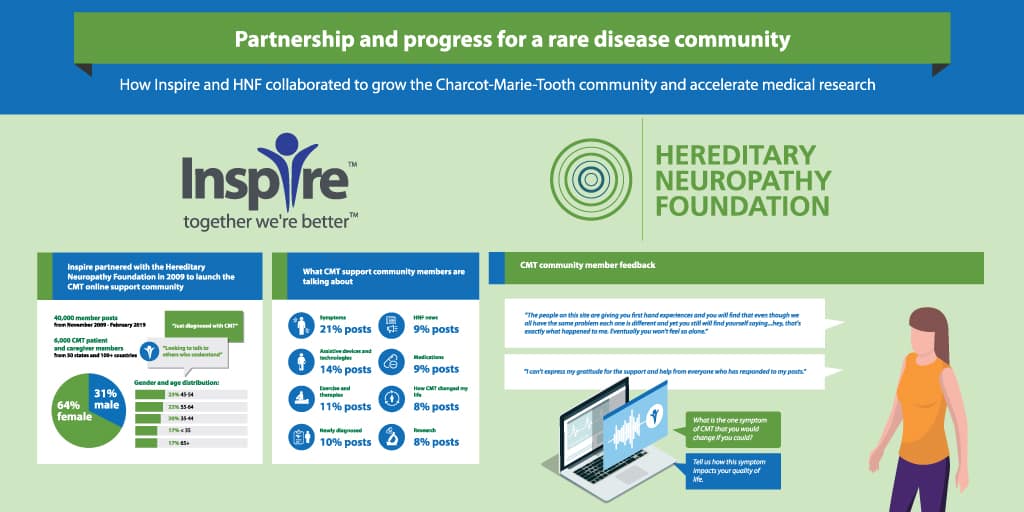Collaborating with Rare Disease Patient Advocacy Organizations

The first Rare Disease Day took place on February 29, 2008, chosen because February 29 is a “rare date.” Since then, it has continued to occur on the last day of February. Inspire will participate in this year’s worldwide awareness effort to help inform the general public and policy makers about the impact of rare diseases on patients’ lives at the annual Rare Disease Day at National Institutes of Health with a poster and exhibit booth on February 28.
Defined as affecting less than 200,000 people in the US, at one time having a rare condition made it very difficult to meet others affected by the same condition.1 Today, research indicates that social media has a positive influence on the psychological health of people dealing with rare disease through the connections, communication and support they receive from others with their condition.2,3
Inspire partners with approximately thirty rare disease non-profit patient organizations to create online support communities where rare patients and caregivers can connect to share support and information. One Inspire partner, the Hereditary Neuropathy Foundation (HNF), supports individuals affected by Charcot-Marie-Tooth (CMT), a rare progressive neurological disease. Since 2009, people  affected by CMT have had a virtual home at the Charcot-Marie-Tooth Support Community on Inspire. Starting with a small number of CMT patients and caregivers, membership has grown to around 6,000. One member described the impact this way,
affected by CMT have had a virtual home at the Charcot-Marie-Tooth Support Community on Inspire. Starting with a small number of CMT patients and caregivers, membership has grown to around 6,000. One member described the impact this way,
“The people on this site are giving you first hand experiences and you will find that even though we all have the same problem, each one is different and yet you still find yourself saying…hey, that’s exactly what happened to me. Eventually you won’t feel so alone.”
The Inspire and HNF Poster
Founded in 2001 by Allison Moore, HNF has collaborated closely with Inspire since our partnership began in 2009. HNF leveraged its CMT support community on Inspire to support research and advocacy initiatives focused on improving the quality of life of CMT patients. Some of this work – most notably, the recognition of pain as a major treatment endpoint and clinical trial outcome measure – will be presented during a poster session at Rare Disease Day at NIH.
“I was surprised to read that ‘Nerve pain is not a common feature of CMT,’ as stated in the ‘new’ CMT factsheet.” ~Inspire member
Although pain is a recurring theme in Inspire’s CMT community postings, it was not previously a recognized part of the symptomatology. One patient in the community said,
“Recently my primary Doctor told me that I had to be lying about my experiences with symptoms.”
Other members reported,
“I knew CMT ran in my family but my primary wouldn’t order the test I needed. Because I didn’t have the deformities he saw while researching he didn’t think I had CMT. I spent two years fighting with him, I would explain my symptoms and he brushed them off. I felt like I was going crazy. I began having anxiety attacks.”
“Over the past 18 months, pain began, and hit hard. Significant fatigue and inability to stand for more than a few seconds. I can still walk for about .5 – 1 mi, but am wiped out after that. Now my hands are losing feeling and I drop things.”
“I usually have a high pain tolerance, but lately even with all the meds I am on, I have been in a ridiculous amount of pain, to where i can barely walk without crying.”
“anyone else has sharp, zinging pains in their legs?”
“We call them lightning bolts….I’ve had them for many years now. They started in the head, but I get them all over and of late, I’ve been getting them on my tongue where we can see the actual damage these lightning bolts can do. Depending upon direction they can constrict my breathing by affecting surrounding muscles…”
To address a CMT symptom that was seldom recognized by the medical community, HNF documented frequent and recurring mentions of pain in Inspire’s CMT community. In addition, at the end of 2017, they hosted a Patient-Centered CMT/HNPP Pain Summit in Boston. This event included a presentation by John Novack, Director of Communications at Inspire, in which he, along with Moore, conducted a live-time text poll with the almost 100 audience members to further explore chronic pain within the CMT/HNPP community. A member of Inspire’ CMT community reported the findings in a post on Inspire.
“64% of audience respondents stated they had chronic pain that was a combination of neuropathic, muscle and skeletal/ bone pain.
61% of respondents stated they had a combo of achy/sore, sharp/ stabbing, and tingling/electrical pain.
The majority of respondents said their chronic pain rated 4-6 on a pain scale (with 10 being worst/completely debilitating pain).
Most reported moderate to severe interference with their general activity, mood, and stress levels.
Most reported moderate to severe impacts on sleep.”
The member concluded the update by saying,
“As a result, HNF now has some initial data to support further research and, hopefully, publication that documents the correlation between CMT/HNPP and pain!”
HNF has implemented additional initiatives to explore the impact of pain on CMT including a patient-reported outcomes study. Similarly, HNF’s exploration of content from the CMT support community on Inspire identified psychosocial health as a potential unmet need among CMT patients. As a result, HNF addressed psychosocial health in its natural history study and Patient-Centered Behavioral Health Summit.
Additionally, in preparation for an Externally-Led Patient Focused Drug Development (EL-PFDD) meeting, HNF and Inspire collaborated to use voice-activated technology to capture CMT community members own voices answering two survey questions, “What is the one symptom of CMT that you would change if you could?” and “Tell us how this symptom impacts your quality of life.” With over 200 responses, a representative sample was presented at the EL-PFDD meeting in a video montage (see the first five minutes of the video).
As a result of these efforts, pain is now recognized as an important endpoint in CMT treatment and as an outcomes measure in clinical trials. Psychosocial health is being further investigated. HNF and Inspire continue to explore opportunities to collaborate to accelerate medical progress and support patients living with CMT.
Join us on February 28 at Rare Disease Day at NIH.
Editor Note: Last week, Inspire held a webinar “Diversity in Clinical Trials: Understanding patient and caregiver perspectives. If you missed it or would like to hear it again, you can download the webinar here:“Diversity in Clinical Trials: Understanding Patient and Caregiver Perspectives.”
Inspire offers a trusted community to patients and caregivers. Our goal with this blog, this website and our content is to provide the life science industry access to the true, authentic patient voice. In so doing, we support faithful operationalization of patient-centricity. Take a look at our case studies, eBooks and news outlet coverage.
References:
1 NORD-National Organization of Rare Disorders. (2019). Retrieved from https://rarediseases.org/for-patients-and-families/information-resources/patient-and-caregiver-resource-center/resources-faqs/
2 Glenn, A. (2015). Using online health communication to manage chronic sorrow: Mothers of children with rare diseases speak. Journal of Pediatric Nursing, 30 (1)17-34. https://doi.org/10.1016/j.pedn.2014.09.013
3 Doyle, M. (2015). Peer support and mentorship in a US rare disease community: Findings from the Cystinosis in Emerging Adulthood Study. The Patient, 8(1)65-73. https://link.springer.com/article/10.1007/s40271-014-0085-9






